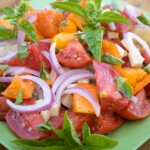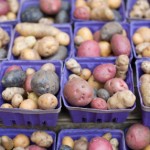We got a new dog almost three weeks ago, another Tibetan terrier, but this time a retired show dog. So I'm been intetested in what he eats (dry dog food, but a specific brand and for senior canines). I guess it was logical that when I saw an article on phytonutrients in The New York Times this morning, that my first thought was of "Fido nutrients." Of course that wasn't at all what the writer meant.
I found a background piece specifically on phytonutrients in WebMD; I already knew that the word "Phyto" referred to plants, but was somewhat surprised to read there are over 25,000 of these natural chemicals found in fruits and vegetables as well as in whole grains, tea, beans and nuts. From the plant's point of view, the phytonutrients help defend against its natural enemies (e.g., bugs & germs).
From our point of view, however, they may help prevent disease, visual problems, diabetes, cancer, dementia and heart disease. None of those are as clearcut as I'd like, but I've become a believer in their value. Yet eight out of ten Americans have a "phytonutrient gap," they get less in their diets than they should for optimal health.
I need to emphasize the "may help" part of my comment above; I don't find many large, double-blind, prospective clinical trials that conclude there is an absolute benefit.
What can these chemicals do for us? The National Cancer Institute mentions one significant advantage; they help protect us from free radicals, atoms or groups of atoms that have an odd number of electrons, those tiny negatively charged particles that circle the nucleus of an atom. They are formed when oxygen interacts with certain chemicals and react with cells, especially with their DNA.
Antioxidants are believed to have a role in slowing the aging process and in animal studies have helped prevent the free radical damage that is associated with cancer. Human studies have been inconclusive thus far.
There seems to me, at the current state of knowledge, to be no logic behind taking supplements to increase your intake of antioxidants. But eating more fruits and vegetables and picking which ones you eat is an entirely different story.
A 2010 article in e! Science News highlighted the concept that trying different fruits and veggies could help us increase our daily intake of phytonutrients. To start with, even those of us who follow the current guidelines to consume less red meat and eat a lot more fruits and veggies tend to eat more sweet varieties than is optimal. We need, as I just did, to occasionally eat some rhubarb or other less sweet fruit and add more herbs in our cooking.
By and large, the concept "Eat Your Colors," as I found in a University of Minnesota advisory piece online, is the clue to getting a significant amount of of the various phytochemicals in your diet. There are five different fruit and vegetable hue groups: red, yellow/orange, purple/blue, green and white/tan.
When we traveled to South America eight years ago we were amazed at the variety of vegetables available in a local market in Peru. One kind of potato was purple and, according to an article I read today in The New York Times, that variety has twenty-eight times as much of a particular useful chemical as russet potatoes do. That chemical is believed to help fight cancer, but some studies say it doesn't get into the body in an active form when the plant it's found in is eaten.
The NYT article was titled "Breeding the Nutrition Out of Our Food," and was written by an investigative journalist, Jo Robinson, who has a book about to be published, Eating on the Wild Side: The Missing Link to Optimum Health. She's been writing in the field of nutrition for years.
Robinson mentions that wild dandelions, formerly eaten by Native Americans, have much higher levels of these chemicals than spinach and one kind of apple (she doen't specify which) has 100 times the levels of phytonutrients as its Golden Delicious competitors. I gave up on that rather blah-tasting apple and its Red Delicious sibling years ago and now look for Rome, Galas, Fuji, Granny Smith and Braeburn varieties.
Her basic premise is that humans have been picking sweeter fruits and vegetables for thousands of years; most of these are low fiber, high sugar (and starch and oil) varieties. Sweet corn is a key example where we've trended over the years to a vegetable that's lower in some helpful chemicals than blue, black or red corn.
I've been very intrigued as I read five articles on the subject today. I agree there's no definitive data that tells me to eat my colors and eschew the most common choices availble at supermarkets. I do know that the tomatoes we've gotten from a local CSA are much more flavorful than those I see on the shelves in the store.
The other way of looking at the concept, even if you don't accept that phytonutrients are the answer to many of our health issues, is to say when you concentrate on fruits and veggies and fill well over half your plate (preferably three-quarters), you have less room for meat. And when you choose fruits and vegetables with unusual colors, you serve a more attractive plateful of food.
That's a reasonable start.



